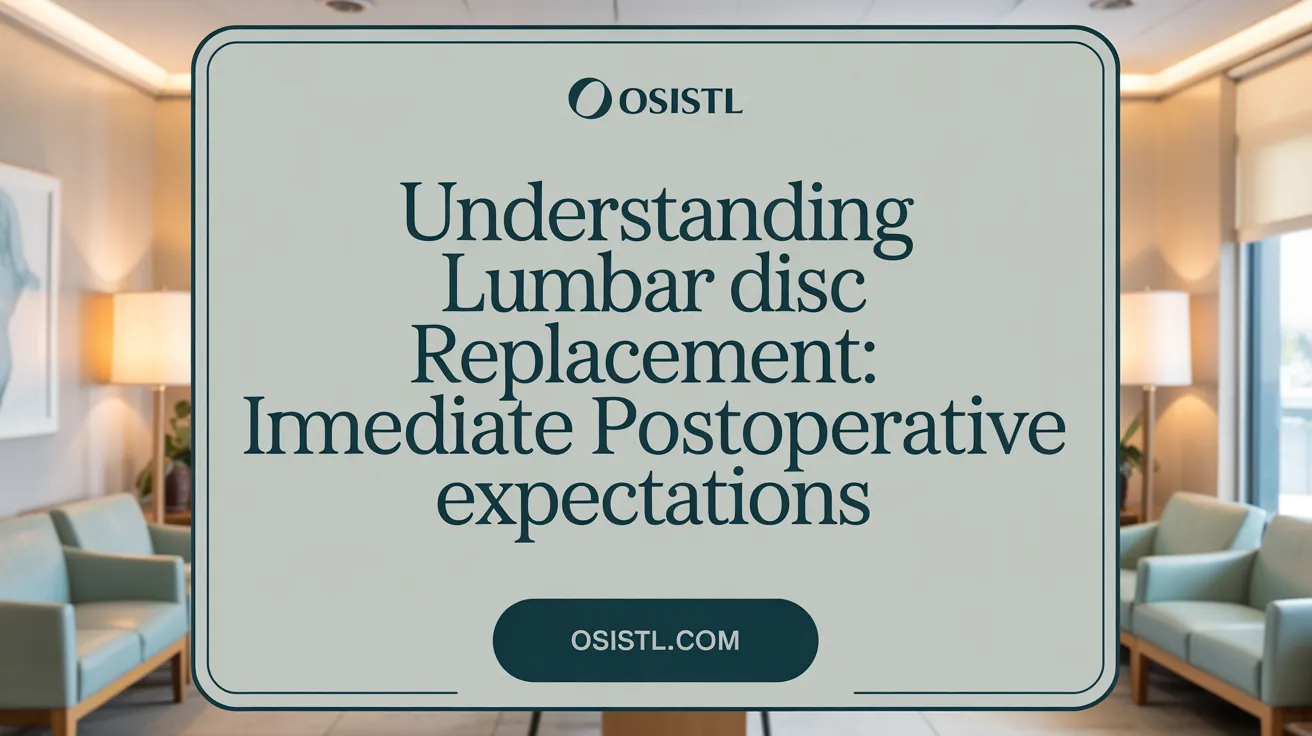Understanding Lumbar Disc Replacement and Its Recovery Journey
Lumbar disc replacement (LDR) has emerged as a progressive alternative to spinal fusion surgery, designed to relieve chronic low back pain by replacing damaged spinal discs with artificial implants. Unlike spinal fusion, which permanently immobilizes vertebrae, disc replacement aims to restore natural spinal motion and flexibility. This article unpacks the recovery process following lumbar disc replacement surgery, providing critical insights and practical tips to optimize healing, manage pain, and safely return to everyday activities.
Overview of Lumbar Disc Replacement Surgery and Immediate Postoperative Care

What does lumbar disc replacement surgery involve and what should patients expect immediately after the procedure?
Lumbar disc replacement surgery is performed through a small vertical incision in the abdomen using an anterior surgical approach. This minimally invasive technique allows the surgeon to remove the damaged disc and replace it with an artificial disc designed to mimic the natural movement of the lumbar spine. This approach helps preserve spinal mobility and restores alignment.
After the procedure, patients typically stay in the hospital for 1 to 2 days, consistent with the hospital stay expectations after lumbar disc replacement. Recovery starts quickly as walking is usually encouraged within a few hours post-surgery to promote blood flow and reduce risks like blood clots. Early mobilization supports healing and improves endurance.
Postoperative symptoms commonly include manageable lower back pain, occasional leg pain, numbness, or tingling caused by inflammation or nerve irritation from the surgery. Some patients also experience sore throat or hoarseness related to the anesthesia and intubation process. Pain management protocols involve prescribed pain relievers, steroids to reduce inflammation, and muscle relaxants if needed to alleviate discomfort.
Incision care is a crucial part of preventing infection and ensuring proper wound healing. Typically, the surgical dressing is removed the day after surgery, while skin tapes remain in place for 5 to 10 days until they fall off naturally. Showering is allowed with caution the day after surgery; however, soaking or scrubbing the incision site must be avoided. Patients are closely monitored for signs of infection such as redness, warmth, swelling, pus, or fever, which require immediate medical attention.
Adhering to these immediate postoperative care guidelines helps optimize recovery outcomes and supports a smooth transition toward eventual physical therapy and gradual return to daily activities.
Typical Recovery Timeline and Activity Recommendations After Lumbar Disc Replacement

What is the typical timeline and key milestones for recovery after lumbar disc replacement?
Recovery after lumbar disc replacement usually begins immediately, with patients standing and walking on the day of surgery. Within the first 6 weeks, most patients experience significant improvements, achieving roughly 75% pain relief. By around 3 months post-surgery, pain relief can reach approximately 90%, allowing many to resume near full activities. For more details, see Artificial disc replacement recovery time and Artificial disc replacement recovery timeline.
Initially, activity restrictions are important to support healing. Patients are typically advised to limit lifting, pushing, and pulling to 10-20 pounds for the first two weeks. Bending, twisting, and heavy lifting are avoided for 4 to 6 months to prevent undue stress on the healing spine. Refer to Activity restrictions after surgery for more guidance.
Return to work is often possible within 1 to 2 weeks, particularly for those with sedentary or light-duty jobs. More physically demanding roles may require additional modifications or longer recovery periods. Regular follow-ups and imaging help monitor progress and guide activity adjustments. See Returning to work after lumbar disc replacement and Follow-up appointments after artificial disc replacement.
The use of lumbar braces or corsets is sometimes recommended briefly after surgery to support the lower back, but many patients recover well without them. Driving should be avoided while patients are taking prescription pain medications and only resumed once medically cleared to ensure safety. For more, consult Driving restrictions after surgery.
This structured recovery plan balances protecting the surgical site with the gradual resumption of normal movement, promoting optimal healing and restoration of spinal function. Learn more from Lumbar Disc Replacement Physical Therapy and Postoperative spine rehabilitation protocols.
Role of Physical Therapy in Lumbar Disc Replacement Recovery

How does physical therapy contribute to recovery after lumbar disc replacement and when does it typically start?
Physical therapy is vital in the recovery process after lumbar disc replacement, primarily aimed at reducing pain, inflammation, and restoring spinal function. It typically begins around two weeks post-surgery, allowing initial healing before commencing gentle rehabilitation exercises (Lumbar Disc Replacement Physical Therapy, Postoperative Physical Therapy for Disc Replacement, Early rehab and pain management).
Phased physical therapy approach
Postoperative rehabilitation follows a structured, phased approach:
- Phase I (0-12 weeks): Emphasis on pain control, gentle walking, inflammation reduction, and avoiding movements like bending, twisting, or lifting over 15 pounds. Patients practice good posture and learn body mechanics to prevent strain (Phase I Rehabilitation Guidelines, Avoiding extension and rotation).
- Phase II (2-6 weeks onwards): Focuses on neuromuscular control and initial strengthening of core muscles, including the transverse abdominis and multifidi, along with light resistance training and cardiovascular tolerance (Phase II Initial Strengthening, Phase II neuromuscular control restoration.
- Phase III (6-8 weeks): Advanced strengthening, balance exercises, and reconditioning for return to work, sports, and daily activities. Higher level exercises such as running, agility drills, and plyometrics may begin based on clinician approval (Phase III Advanced Strengthening, Return to Sport and Work).
Specific exercises and precautions
Key exercises involve abdominal bracing, multifidi isometric contractions, gluteal sets, and light stretching targeting hamstrings, quadriceps, and hip flexors. Aquatic therapy may be introduced early to lessen load on the spine. Throughout rehabilitation, extension and rotation movements are avoided for the first 6-8 weeks to protect the surgical site (Physical Therapy Post Lumbar Disc Surgery, Avoiding Movements After Lumbar Disc Replacement.
Goals of physical rehabilitation
The overarching goals include decreasing pain and swelling, improving mobility and postural habits, restoring core stability, increasing endurance, and safely returning patients to pre-surgical activity levels with improved spinal mechanics (Post-operative spine rehabilitation, Rehabilitation progression criteria.
By adhering to this phased, carefully supervised physical therapy protocol, patients optimize their recovery, maintain spinal motion, and reduce the risk of complications or prolonged disability after lumbar disc replacement (Lumbar Disc Replacement Physical Therapy, Postoperative care after lumbar disc replacement).
Pain Management and Medication Strategies Following Lumbar Disc Replacement
What are common pain management strategies after lumbar disc replacement surgery?
Pain after lumbar disc replacement is typical in areas such as the lower back, incision site, hips, and occasionally radiates to the legs. This discomfort tends to improve gradually over several weeks.
Medications form the backbone of pain control:
- Non-opioid analgesics like acetaminophen and NSAIDs (ibuprofen, naproxen) are commonly used.
- Low-dose opioids may be prescribed initially for severe pain but are typically tapered quickly.
- Steroid dose packs help reduce inflammation.
- Muscle relaxants may be included to ease muscle spasms.
Non-drug methods also play a vital role:
- Ice packs are recommended to reduce swelling and numb pain.
- Heat therapy is discouraged early after surgery to avoid increased inflammation.
- Early and consistent walking encourages circulation and healing.
For more detailed guidance on these strategies, see Pain management after spine surgery and Postoperative pain management.
What risks and precautions accompany pain medication usage?
Certain precautions are important to ensure safe recovery:
- Avoid alcohol and blood thinners while on pain medication to prevent complications.
- Use stool softeners proactively to counter medication-induced constipation.
- Driving is not recommended while taking narcotic medications due to impaired alertness.
Effective pain management after lumbar disc replacement involves adhering to prescribed medications, integrating recommended physical activity gradually, and maintaining open communication with healthcare providers. Reporting persistent or worsening pain is essential to rule out complications or adjust treatment.
For more information on pain medication precautions and postoperative care, refer to Postoperative spine rehabilitation protocols and Lumbar disc replacement incision care.
Postoperative Activity Restrictions, Precautions, and Lifestyle Modifications

What activity restrictions and lifestyle advice help optimize recovery after lumbar disc replacement?
After lumbar disc replacement surgery, patients must adhere to specific activity restrictions after surgery and lifestyle guidelines that support the healing process and enhance surgical success. Notably, lifting, pushing, and pulling limitations should be limited to 10-20 pounds for the first two weeks. More strenuous activities, especially twisting and heavy lifting, are typically avoided for 4 to 6 months to protect the new disc and surrounding structures from undue strain.
Walking after lumbar disc replacement is strongly encouraged beginning shortly after surgery. Increasing walking duration and frequency gradually helps improve cardiovascular fitness, strengthens core musculature, and boosts overall endurance without compromising spinal stability.
Careful management of the surgical incision is essential. Patients should keep the wound clean, remove dressings as advised(often the day after surgery), and avoid soaking or scrubbing the incision site for about six weeks to prevent infection. Monitoring for infection signs such as redness, swelling, warmth, discharge, and fever is critical to allowing prompt medical intervention if necessary.
Lifestyle factors heavily impact recovery quality. Smoking cessation is crucial since nicotine constricts blood vessels and impedes healing. Maintaining good blood sugar levels, especially in diabetic patients, and managing obesity by sustaining a healthy weight supports tissue repair. Adequate nutrition with protein-rich and balanced meals further accelerates healing. Preparing the home environment by placing essential items within easy reach helps avoid unnecessary bending and twisting, protecting the healing spine.
By combining these movement precautions, proactive wound care, and healthy lifestyle choices, patients can optimize their lumbar disc replacement recovery and return to daily activities more confidently and safely.
Long-term Outlook, Potential Complications, and Patient Considerations
What should patients know about the long-term success, potential complications, and factors affecting outcomes of lumbar disc replacement surgery?
Lumbar disc replacement (LDR) is generally successful in providing significant pain relief and improved mobility, with 80-90% of patients reporting substantial benefits. The artificial discs implanted during surgery can last between 10 and 20 years, and some studies suggest even longer longevity as ongoing research continues to assess outcomes. Many patients experience a notable improvement in quality of life, with reduced pain and restored spinal function (Lumbar Disc Replacement Overview, Lumbar artificial disc replacement).
Potential complications, while relatively rare, include infection, implant failure or displacement, nerve injury, and degeneration of adjacent spinal segments. Complications can be minimized through expert surgical technique and precise implant placement (Lumbar Disc Replacement Surgical Procedure, Lumbar disc replacement surgery. Signs warranting immediate medical attention include severe headaches, bowel or bladder dysfunction, difficulty breathing, chest pain, and symptoms of wound infection such as redness, warmth, swelling, or discharge (Postoperative warning signs).
Choosing appropriate candidates for LDR is crucial. Ideal patients typically have degenerative disc disease without significant spinal deformities (e.g., severe scoliosis), no advanced facet joint disease, and good bone quality. Surgeon experience and skill play a vital role in ensuring optimal implant placement and reducing the risk of complications (Candidates for lumbar disc replacement, Importance of surgeon expertise). Personalized treatment and thorough preoperative evaluation contribute to better surgical outcomes (Pre-surgical assessment for lumbar disc arthroplasty).
Insurance coverage for lumbar disc replacement varies widely. While many major insurance plans and some Medicare policies cover the procedure when criteria are met, patients should verify their benefits beforehand. The financial considerations, including potential out-of-pocket costs, should be discussed prior to surgery to plan effectively (Insurance coverage for lumbar disc replacement, Financial considerations and insurance. Maintaining regular follow-up appointments and adhering to postoperative care instructions are essential for maximizing the success and longevity of the disc replacement (Follow-up care after lumbar disc replacement.
In summary, lumbar disc replacement can offer significant and lasting relief when performed on well-selected patients by experienced surgeons, with careful attention to postoperative care and financial planning to support recovery and long-term health (Artificial disc replacement overview, Long-term clinical outcomes of lumbar total disc replacement).
Successful Recovery: Empowering Patients Post-Lumbar Disc Replacement
Lumbar disc replacement surgery represents a significant advance in treating degenerative disc disease by preserving spinal motion and promoting a quicker return to daily activities compared to traditional fusion. Recovery involves a carefully staged process including early mobilization, vigilant pain management, adherence to activity restrictions, and structured physical therapy. Patients benefit most by following medical guidance closely, embracing lifestyle changes like smoking cessation and healthy weight management, and maintaining open communication with their healthcare team. With appropriate patient selection and surgical expertise, lumbar disc replacement offers a promising path toward lasting pain relief and restored quality of life.
